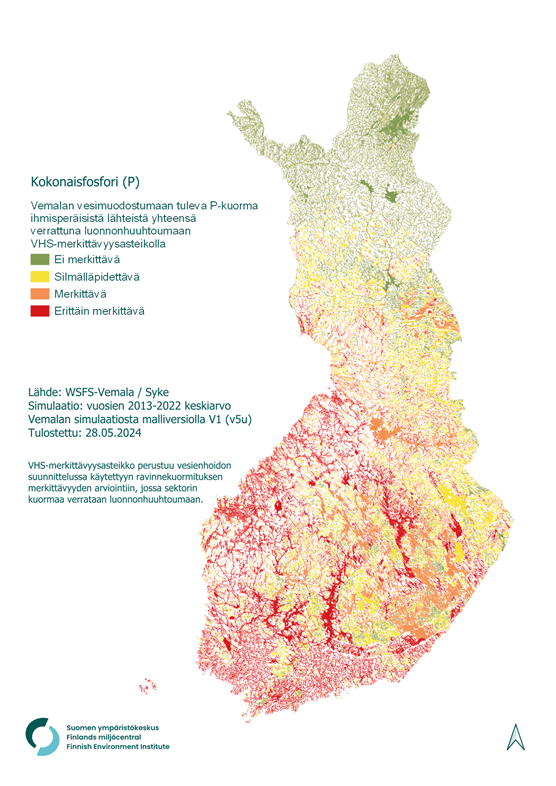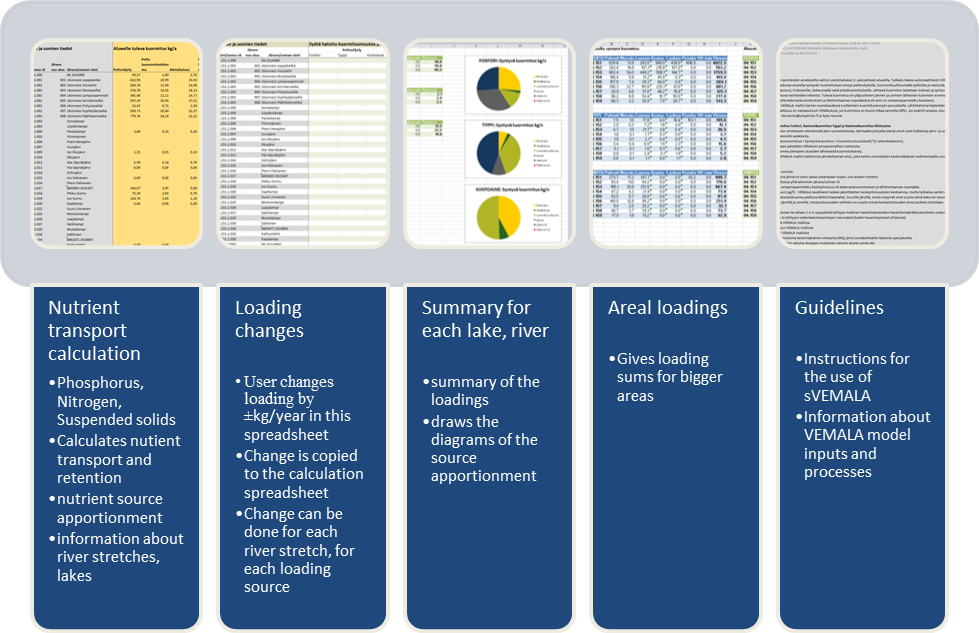WSFS-Vemala (Vemala)
The Vemala model is an operational, national scale nutrient loading model for Finnish watersheds (Huttunen et al., 2016). It simulates nutrient processes, leaching and transport on land and in rivers and lakes. The model simulates nutrient gross load, retention and net load from Finnish watersheds to the Baltic Sea. It includes two main sub-models, the WSFS hydrological model (Vehviläinen, 1994) and the Vemala water quality model (Huttunen et al., 2016). The model was developed through the years and two versions (V1 and V3) are operational today simulating different nutrients and processes. Successive versions of the model have been developed leading to a more process-based nutrient loading model. WSFS-Vemala is part of the Watershed simulation and forecasting system (WSFS) of Finnish Environment Institute Syke.

Vemala model structure
Description of Vemala model versions V1 and V3
| |
V1
|
V3
|
|
SUBSTANCE
|
TP, TN, SS, TOC |
TP, TN, SS, TOC,
PO43-, PP, Porg, NO3-, NH4+, Norg, phytoplankton, O2 |
|
HYDROLOGICAL MODEL
|
WSFS |
WSFS |
|
TERRESTRIAL MODEL
|
Agriculture
|
VEMALA-ICECREAM
(TP, TN)
concentration-runoff relationship (SS)
partly process-based simulation of terrestrial C processes (TOC)
|
VEMALA-ICECREAM
(TP, TN, PO43-, PP, Porg, NO3-, NH4+, Norg)
concentration-runoff relationship (SS)
partly process-based simulation of terrestrial C processes (TOC)
|
|
Other land areas
|
concentration-runoff relationship,
VEMALA-N (Metsävesi)
partly process-based simulation of terrestrial C processes (TOC)
|
concentration-runoff relationship,
VEMALA-N (Metsävesi)
partly process-based simulation of terrestrial C processes (TOC)
|
|
RIVER MODEL
|
nutrient transport model |
biogeochemical model |
|
LAKE MODEL
|
nutrient mass balance model |
biogeochemical model |
Examples of Vemala results and use cases
Vemala can simulate the water quality on a daily basis in rivers and lakes larger than one hectar in Finland and provide real-time results. It can also analyse the contribution of the different loading sources to the total or biologically available nutrients as well as the proportion of biologically available fractions in the runoff to the sea. Vemala can also be used to simulate the impact of various farming actions and loading reduction actions on the total or biologically available nutrient loads to help implement the Water Framework Directive. Moreover, it can take into account the effect of climate change on the total or biologically available nutrient loads reaching the sea. Finally, Vemala can simulate the transport of inert components in the river network to determine the toxicity downstream of an accidental leak.
Below are some examples of Vemala model results. More example maps are available from the Finnish Vemala website.

Contribution of various sources to the phosphorus loading to the Baltic Sea without taking into account the direct deposition to the Sea (source: WSFS-Vemala/Syke)

Phosphorous (P) loading to waterbodies from human sources vs. background loading (green <40%, yellow 40-100%, orange 100-200%, red >200%) © WSFS-Vemala/Syke

Phosphorous (P) loading to waterbodies from human sources vs. background loading (green <30%, yellow 30-50%, orange 50-100%, red >100%) © WSFS-Vemala/Syke
Details about Vemala model
Vemala-N
VEMALA-N simulates nitrate (NO3-), organic nitrogen (Norg) and total nitrogen (TN) leaching and load formation at a catchment scale. The simulation unit is crop/land use class with 5 agricultural crop classes and one forest class. The model simulates the dependency of the main processes (mineralisation, nitrification, denitrification, plant uptake) on the soil moisture and temperature. VEMALA-N can be used to run scenarios to simulate the effect of a changing climate on the nitrate leaching and its sub-processes or the effect of changing crops and fertilisation (both mineral and organic) on the nitrate leaching. The results form the VEMALA-N sub-model and the forest loading for P are then adjusted to the Metsävesi results (Metsävesi, 2020).

Scheme of the conceptual hydrological model and VEMALA-N
Vemala-ICECREAM-P
VEMALA-ICECREAM simulates particle bound and dissolved phosphorus (PP and DP) load and erosion from agricultural areas. It is a field-scale, process based model (e.g. Jaakkola et al. 2012), applied to all fields in Finland. The field characteristics – soil type (clay, silt, coarse and peat), field slope and the size of a rectangle-shaped field plot – are used in the simulations. The output from the ICECREAM model (daily total P load) is used as an input to the VEMALA model. Agricultural measures that are taken into account in ICECREAM and can be used in management scenarios are
- Amount, depth of application and type of fertilizer (mineral/manure)
- Annual crops (also over winter), perennials and root crops, 13 different crops parameterized
- Conventional tillage, direct sowing
- Dates for agricultural practices
- Buffer zones/strips

Simulation of phosphorus flows in the ICECREAM model
Vemala-ICECREAM-N
Process-based N simulation in ICECREAM is based on the GLEAMS model (Knisel, 1993). ICECREAM simulates the daily balance of organic matter, organic N, ammonium (NH4-N) and NO3-N pools by accounting for input of plant residues, organic and mineral fertilizer, atmospheric deposition, fixation by plants and decay of organic matter. Processes reducing N in the soil are plant uptake, denitrification, volatilization and transport with runoff and leaching. ICECREAM application on each filed provides the total agricultural loading of following N fractions – TN, organic N, ammonium (NH4-N) and NO3-N as input to the Vemala model for catchment scale loading simulations.

Simulation of nitrogen flows in the ICECREAM model
Vemala TOC
Vemala TOC model simulates TOC processes in the soils. TOC leaching depends on the C storage, soil moisture, temperature and runoff conditions. C in soil is described with three storages – solid organic carbon (SOC), dissolved organic carbon (DOC) and dissolved inorganic carbon (DIC). The main processes described in the model are mineralization of organic carbon (OC), dissociation of OC and production of DOC, association of DOC back into SOC. Model simulates TOC leaching from 6 land use classes in the model: agriculture on clay soils, agriculture on coarse soils, agriculture on peat soils, forests on mineral soils, forests on ditched peat soils and natural peatlands. Vemala TOC model is being further developed in ongoing projects.

Simulation of carbon processes in Vemala TOC model
Vemala v.3
Vemala v.3 model uses the terrestrial input from VEMALA-N for NO3- and Norg, VEMALA-ICECREAM for PO43-, PP and Porg and VEMALA 1.1 for total organic carbon (TOC) and suspended solids (SS). The phytoplankton growth is simulated using the AQUAPHY model (Lancelot et al. 1991) and the nutrient cycling using a simplified version of the biogeochemical model RIVE (Billen et al., 1994). The bioavailable nutrients are linked in the aquatic ecosystem to one another through phytoplankton dynamics, organic matter degradation and sedimentation.
VEMALA v.3 can simulate the loads of total and bioavailable nutrients (NO3- and PO43-) to the sea with the contribution of the different loading sources. The impact of the different farming actions, loading reduction actions and climate change impact on the nutrient loads.

Scheme of the biogeochemical model in VEMALA v.3
sVemala
sVemala is an excel based nutrient loading simulation tool based on Vemala model results. sVemala is developed to provide the possibility to use Vemala model results independently and to assess the effect of nutrient loading changes on a catchment scale. sVemala contains annual N, P loading, retention, source apportionment of the loading to each river stretch, lake which is simulated in Vemala model. sVemala can be used to assess how the changes in nutrient loading effects on changes in nutrient concentration in downstream lakes and river stretches, as well as to the loading on catchment level. As a new feature sVemala now includes also loading scenarios with different combinations of climate change and water management practices. These scenarios have been simulated with the Vemala model.

sVemala
References
Billen G., Garnier J. & Hanset P. 1994. Modelling phytoplankton development in whole drainage network: the RIVERSTRAHLER Model applied to the Seine river system. Hydrobiologia, 289, 119-137.
Huttunen, I., Lehtonen, H., Huttunen, M., Piirainen, V., Korppoo, M., Veijalainen, N., Viitasalo, M., Vehviläinen, B. 2015. Effects of climate change and agricultural adaptation on nutrient loading from Finnish catchments to the Baltic Sea. Science of The Total Environment. Volume 529, pp 168-181. https://doi.org/10.1016/j.scitotenv.2015.05.055
Huttunen, I., Huttunen, M., Piirainen, V., Korppoo, M., Lepistö, A., Räike, A., Tattari, S., Vehviläinen, B., 2016. A national scale nutrient loading model for Finnish watersheds – VEMALA. Environmental Modelling and Assessment 21(1), 83–109. DOI: 10.1007/s10666-015-9470-6
Jaakkola, E., Tattari, S., Ekholm, P., Pietola, L., Posch, M. & Bärlund, I. 2012. Simulated effects of gypsum amendment on phosphorus losses from agricultural soils. Agricultural and Food Science 21: 292–306.
Korppoo, M., Huttunen, M., Huttunen, I., Piirainen, V., Vehviläinen, B., 2017. Simulation of bioavailable phosphorus and nitrogen loading in an agricultural river basin in Finland using VEMALA v.3. Journal of Hydrology, 549, 363–373. http://doi.org/10.1016/j.jhydrol.2017.03.050
Lancelot C., Veth C. & Mathot S. 1991. Modelling ice-edge phytoplankton bloom in the Scotia-Weddell sea sector of the Southern Ocean during spring 1988. Journal of Marine Systems (2):333-346.
Leena Finér, Ahti Lepistö, Kristian Karlsson, Antti Räike, Sirkka Tattari, Markus Huttunen, Laura Härkönen, Samuli Joensuu, Pirkko Kortelainen, Tuija Mattsson, Sirpa Piirainen, Sakari Sarkkola, Tapani Sallantaus, Liisa Ukonmaanaho, 2020: Metsistä ja soilta tuleva vesistökuormitus. Valtioneuvoston selvitys- ja tutkimustoiminnan julkaisusarja 2020:6 ISSN 2342-6799 ISBN PDF 978-952-287-826-7. https://julkaisut.valtioneuvosto.fi/bitstream/handle/10024/162009/VNTEAS_2020_6.pdf?sequence=4&isAllowed=y
Vehviläinen B. 1994. The watershed simulation and forecasting system in the National Board of Waters and the Environment. Publications of the Water and Environment Research Institute. National Board of Waters and the Environment, Finland No. 17.
Projects (partly in Finnish)
- VESSU-ST: Vesienhoidon suunnittelutyökalun suunnittelu ja toteutus (VESSU-ST)
- BlueLakes: Digitizing the Carbon Sink Potential of Boreal Lakes (BlueLakes)
- Green-Digi-Basin: Green and digital transition in river basin management (Green-Digi-Basin)
- BlueAdapt: Sopeutuminen sinisen kasvun avaimena (BlueAdapt), lisätietoa: hankesivu (blueadapt.fi/en/)
- KIPSI: hankesivu (seuranta.vaikutavesiin.fi)
- KLIVA: KLIVA – Vesitase, ekosysteemipalvelut ja metallikulkeuma muuttuvassa ilmastossa, posteri (pdf)
- SysteemiHiili: Comprehensive assessment of climate measures in catchments - with system analysis towards carbon-neutral land use (SysteemiHiili)
- Vemala TOC model development, lisätietoa: raportti I (pdf), raportti II (pdf)
- KaiHali: Kaivosvesiä vastaanottavien vesistöjen hallinta ja kunnostaminen (KaiHali)
- SulfaII: Toimintamallit happamuuden ennakoimiseksi ja riskien hallitsemiseksi turvetuotantoalueilla (Sulfa 2)
- LOHKO I & II: Lohkon ominaispiirteet huomioiva ravinnekuormitusmallinnus ja sen kehittäminen, lisätietoa: hankesivu (mtk.fi), raportti (pdf)
- N-SINK: Reduction of waste water nitrogen load: demonstrations and modelling, lisätietoa: hankesivu (jyu.fi), raportti (pdf)
- MINEVIEW: Monimuuttujallinen tarkastelu arvioitaessa kaivostoiminnan metallipäästöjen ekotoksilogisia ja ympäristöterveydellisiä riskejä sekä niiden kokemista lähialueilla, lisätietoa: hankesivu (jyu.fi)
- Rannikon kokonaiskuormitusmallin (FICOS) kehittämishankkeet, lisätietoa: tiedote (syke.fi), raportti (pdf)
More information
Markus Huttunen, Inese Huttunen, Marie Korppoo,
Nasim Fazel, Maiju Narikka, Tiia Vento
vemala@syke.fi tai firstname.lastname@syke.fi